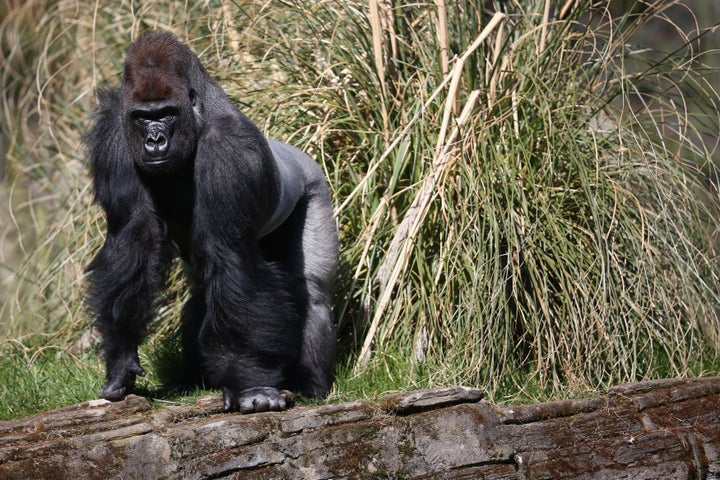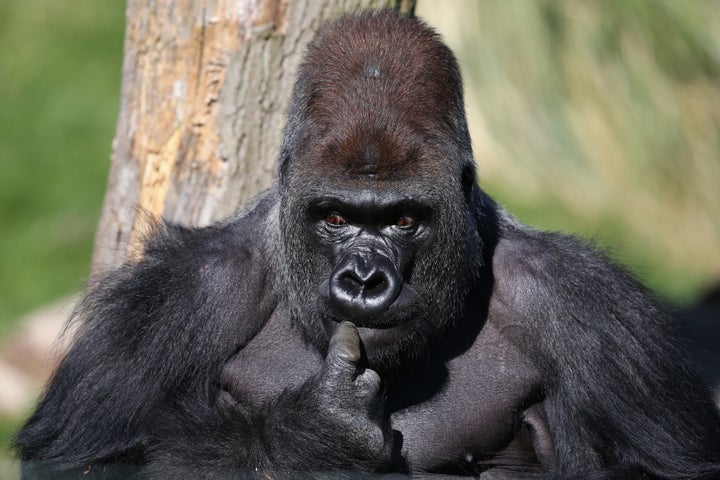A wildlife charity has called for an “urgent inquiry” after a 29-stone gorilla escaped from its enclosure in London Zoo, saying the £5.3 million spent on his enclosure was a waste as “gorillas can obviously escape from it.”
The male Silverback called Kumbuka escaped into the secure keepers’ area on Thursday afternoon, prompting visitors to be locked in buildings while armed police, zoo keepers and a helicopter were involved in trying to recapture him.
Chris Draper, Associate Director of Animal Welfare at the Born Free Foundation, said he was “very disappointed” with the Zoo and videos that showed visitors “shrieking and shouting” at Kumbuka yesterday.
Visitors told how they were held in a café, told to stay away from the window and then escorted out by armed police.
He reportedly smashed the window of his ‘cracked’ enclosure at the zoo and was free for 90 minutes before armed keepers tranquilised him, according to The Daily Mail.

One person tweeted an image of one the gorillas, saying it threw itself at the window just two seconds later.
“I’m very disappointed with London Zoo,” Draper told BBC Radio 4’s Today programme. “Accidents do happen, but this is a concerning turn of events. This is an enclosure that was built in 2007 at a cost of £5.3 million - funds that as far as I’m concerned could have been far better used conserving gorillas in the wild.
“[The enclosure is] really not an overwhelming piece of of architecture, nor is it in my opinion very fit for purpose, not least that gorillas can obviously escape form it, but the design is not really compatible with natural gorilla behavior.”
Draper said that video footage of visitors “shrieking and shouting” at Kumbuka yesterday showed how few “educational” benefits there were to keeping gorillas in zoos.
The Today played interviews with visitors who were shut in buildings during the escape, one of whom said: “It was like being in Jurassic park, very exciting”.
Eyewitnesses said they were warned not to look him in the eye while he was agitated before he escaped, by some were reportedly “egging him on” in the moments before he charged at the glass, the Mail reports.
“Zoos will often claim that there is an educational role in maintaining these animals for visitors to look at, but I think I need only look at some of the video footage that’s coming through from yesterday’s escape to see that there is a little educational about people watching these animals behind glass, shrieking and shouting when the animal bangs its fist on the glass in frustration,” Draper said.
“The conservation benefits of keeping gorillas in zoo are negligible at best in my opinion.”

“The reality is that gorillas in captivity exist entirely isolated from their counterparts in the wild. The prospects of reintroduction are slim, if not completely absent, and if we’re going to focus on gorilla conservation it needs to be entirely done in the natural habit of gorillas in Africa.”
Host John Humphrys pointed out that although the gorilla only got into the secure keepers’ area rather than public areas of the zoo, “it does raise more questions about whether we should be keeping such huge and dangerous animals caged up in the first place.”
Draper agreed: “We think that the focus should shift away from keeping animals in captivity to look at where the problem is actually taking place. Habitat loss in increasing at a ridiculous rate and we need to focus on where these animals have evolved to live.”
He said the fact that Kumbuka had fathered two baby gorillas in zoos had to be taken with a “pinch of salt” because “there are two more gorillas in captivity, they are not going to necessarily be part of a functioning population in the wild, nor will they be very likely to live in their natural ecosystem, so they may look like a gorilla but they’re not going to be part of natural gorilla population.”
Asked whether he would prefer gorillas get wiped out rather than some remaining alive in captivity, Draper said this was “a very nuanced argument.”
“No-one wants to see any species disappear from the planet, but we need to ask some serious questions about the value of keeping a species alive in perpetuity in captivity, versus trying to fix the problem before it gets to that stage.
“We’re not down to the last few [gorillas], we have a very small population. We need to really shift our attention onto that and stop looking at zoos to be the panacea to conserve their populations in the wild.”
